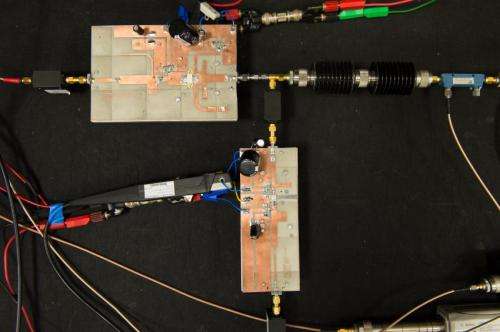This is a signal amplifier. Credit: Department of Electrical and Electronic Engineering, University of Bristol, copyright 2014
A breakthrough in the design of signal amplifiers for mobile phone masts could deliver a massive 200MW cut in the load on UK power stations, reducing CO2 emissions by around 0.5 million tonnes a year.
Funded by the Engineering and Physical Sciences Research Council (EPSRC), the Universities of Bristol and Cardiff have designed an amplifier that works at 50 per cent efficiency compared with the 30 per cent now typically achieved.
Currently, a 40W transmitter in a phone mast's base station* requires just over 130W of power to amplify signals and send them wirelessly to people's mobiles. The new design, however, enables the transmitter to work effectively while using just 80W of power.
If 10,000 base stations in the UK were fitted with the new amplifier, it is estimated that the total saving would amount to half the output of a mid-size, 400MW power station. There are currently around 50,000 phone mast base stations in the UK,** so the potential energy and carbon-saving benefits could be even greater.
The team's development of a less power-hungry amplifier has focused on devising sophisticated new computing algorithms for incorporation into its inbuilt electronic management system, as well as on making a number of adjustments to the amplifier hardware.
Dr Kevin Morris, project leader and Reader in Radio Frequency Engineering, Department of Electrical & Electronic Engineering at the University of Bristol, said: "This new amplifier design represents a step change in energy efficiency that could make a really valuable contribution to meeting the UK's carbon reduction targets."
The team have also succeeded in simplifying the whole amplifier design process, which is of vital importance to encouraging widespread take-up of the project's findings.
"Traditionally, designing signal amplifiers for base stations has been a long, complex process involving a trial-and-error approach and producing one-off solutions," Dr Morris explained. "This has fuelled a reluctance to develop new amplifier designs. To get over that barrier, we've made it a priority to ensure our design is easily replicable."
The team are now working with a major electronics company to take some of the project's key findings towards commercialization.
Provided by University of Bristol






















